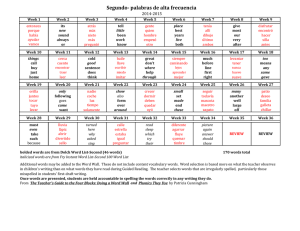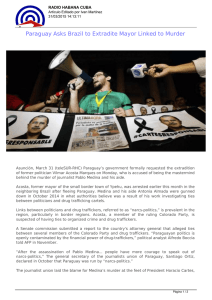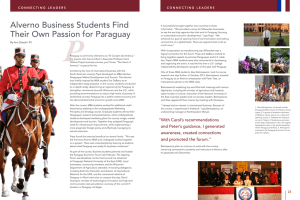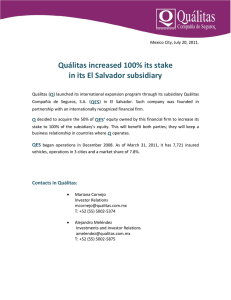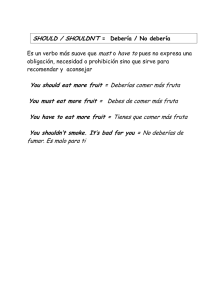Further comments on the application of the name Trochilus lucidus
Anuncio
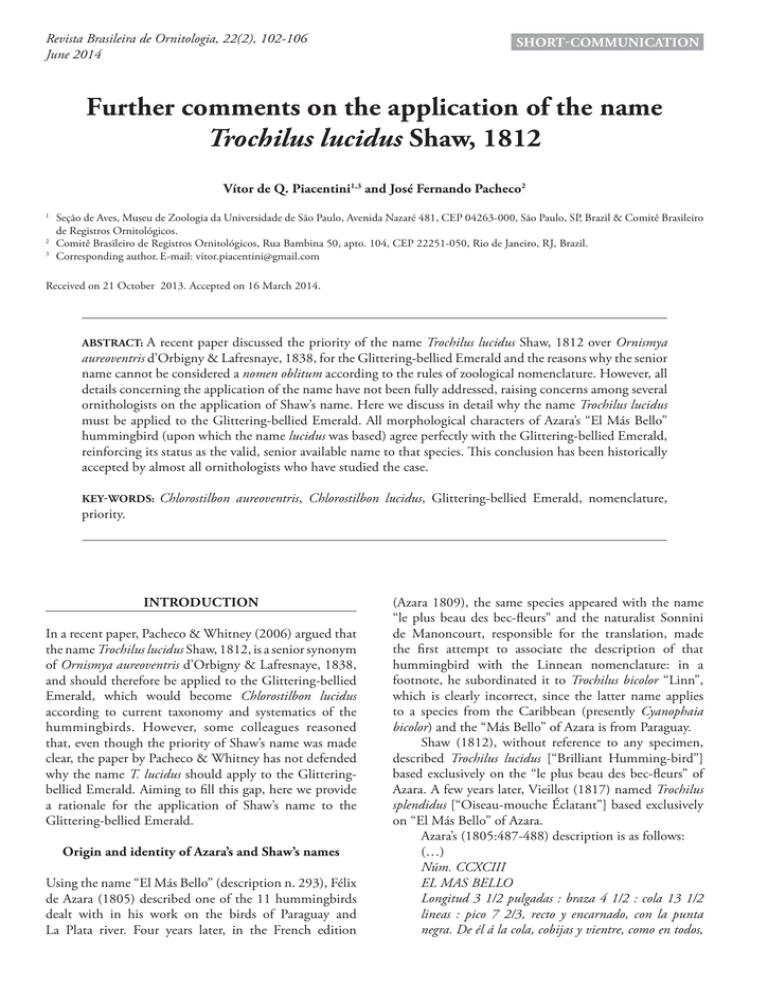
Revista Brasileira de Ornitologia, 22(2), 102-106 June 2014 Short-Communication Further comments on the application of the name Trochilus lucidus Shaw, 1812 Vítor de Q. Piacentini1,3 and José Fernando Pacheco2 Seção de Aves, Museu de Zoologia da Universidade de São Paulo, Avenida Nazaré 481, CEP 04263-000, São Paulo, SP, Brazil & Comitê Brasileiro de Registros Ornitológicos. 2 Comitê Brasileiro de Registros Ornitológicos, Rua Bambina 50, apto. 104, CEP 22251-050, Rio de Janeiro, RJ, Brazil. 3 Corresponding author. E-mail: [email protected] 1 Received on 21 October 2013. Accepted on 16 March 2014. ABSTRACT: A recent paper discussed the priority of the name Trochilus lucidus Shaw, 1812 over Ornismya aureoventris d’Orbigny & Lafresnaye, 1838, for the Glittering-bellied Emerald and the reasons why the senior name cannot be considered a nomen oblitum according to the rules of zoological nomenclature. However, all details concerning the application of the name have not been fully addressed, raising concerns among several ornithologists on the application of Shaw’s name. Here we discuss in detail why the name Trochilus lucidus must be applied to the Glittering-bellied Emerald. All morphological characters of Azara’s “El Más Bello” hummingbird (upon which the name lucidus was based) agree perfectly with the Glittering-bellied Emerald, reinforcing its status as the valid, senior available name to that species. This conclusion has been historically accepted by almost all ornithologists who have studied the case. KEY-WORDS: priority. Chlorostilbon aureoventris, Chlorostilbon lucidus, Glittering-bellied Emerald, nomenclature, INTRODUCTION In a recent paper, Pacheco & Whitney (2006) argued that the name Trochilus lucidus Shaw, 1812, is a senior synonym of Ornismya aureoventris d’Orbigny & Lafresnaye, 1838, and should therefore be applied to the Glittering-bellied Emerald, which would become Chlorostilbon lucidus according to current taxonomy and systematics of the hummingbirds. However, some colleagues reasoned that, even though the priority of Shaw’s name was made clear, the paper by Pacheco & Whitney has not defended why the name T. lucidus should apply to the Glitteringbellied Emerald. Aiming to fill this gap, here we provide a rationale for the application of Shaw’s name to the Glittering-bellied Emerald. Origin and identity of Azara’s and Shaw’s names Using the name “El Más Bello” (description n. 293), Félix de Azara (1805) described one of the 11 hummingbirds dealt with in his work on the birds of Paraguay and La Plata river. Four years later, in the French edition (Azara 1809), the same species appeared with the name “le plus beau des bec-fleurs” and the naturalist Sonnini de Manoncourt, responsible for the translation, made the first attempt to associate the description of that hummingbird with the Linnean nomenclature: in a footnote, he subordinated it to Trochilus bicolor “Linn”, which is clearly incorrect, since the latter name applies to a species from the Caribbean (presently Cyanophaia bicolor) and the “Más Bello” of Azara is from Paraguay. Shaw (1812), without reference to any specimen, described Trochilus lucidus [“Brilliant Humming-bird”] based exclusively on the “le plus beau des bec-fleurs” of Azara. A few years later, Vieillot (1817) named Trochilus splendidus [“Oiseau-mouche Éclatant”] based exclusively on “El Más Bello” of Azara. Azara’s (1805:487-488) description is as follows: (…) Núm. CCXCIII EL MAS BELLO Longitud 3 1/2 pulgadas : braza 4 1/2 : cola 13 1/2 lineas : pico 7 2/3, recto y encarnado, con la punta negra. De él á la cola, cobijas y vientre, como en todos, Further comments on the application of the name Trochilus lucidus Shaw, 1812 Vítor de Q. Piacentini and José Fernando Pacheco pero mas brillantes. Toda la garganta y la cola azules fuertes y constantes, y lo inferior y costados del cuerpo como el lomo, aunque con mas brillo ; de manera que dichos costados en oposicion brillan lo que no puede explicarse. Baxo del cuerpo es lo proprio, con ménos brillo, sucediendo lo mismo a los timoneles inferiores. Tras del ojo hay un punto blanco, que no se vé sino estando muy abierto; y la pluma del oido no es larga como en el precedente. Remos 16, sin salto, y la cola con el mismo seno que la del anterior. (Translation: Length 3 1/2 inches : arm [meaning wing] 4 1/2 : tail 13 1/2 lines : bill 7 2/3, straight and red, with black tip. From it [the bill] to the tail, coverts and belly, as in all [other hummingbirds], but shiner. The whole throat and the tail strong and constant blue, and the underside and the flanks as the back, though with stronger shine; in a way that makes the flanks in opposition shine like one cannot explain. Down on the body it is the same, with less gloss, the same occurring to the underwing coverts. Behind the eye there is a white spot, not seen unless it is wide open; and the auricular feathers are not long as in the previous [species]. Remiges 16, without a break, and the tail forked like the previous [species].) 103 He then compares his bird with Buffon’s “Saphir emeraude” (from Guadalupe and Cayena), even mentioning the emerald green color with golden shine in the neck, back, breast, and belly of Buffon’s bird, and ends with: “Le parece que son variedad un de otro, ó á lo ménos especies muy próximas. Esta descripcion solo difiere de la mia en que niega el seno á la cola” [“It seems they are varieties of each other, or at least very close species. This description differs from mine only in denying the forked tail”]. So, all the above said, one must think of a hummingbird species occurring in Paraguay that fits the description of a very brilliant bird, with a golden shining green color, red bill with black tip, deep blue forked tail, and white spot behind the eye. We see no other option than Glittering-bellied Emerald, “C. aureoventris”. Depending on the point of view, the only inaccuracy would be the “constant blue throat”. However, “C. aureoventris” almost always shines blue in the throat (Figure 1), and that may be the cause of this minor “inaccuracy” of a work from 1805. Not surprisingly, several field guides and books indeed illustrate that species with a blue throat (e.g. Schuchmann 1999; Sigrist 2006; van Perlo 2009). FIGURE 1. Adult male Glittering-bellied Emerald (Chlorostilbon lucidus) photographed in Curitiba, Paraná, Brazil. All characters originally described by Azara for his “El Más Bello” can be seen in this bird: straight, red bill with a black tip; shinning golden-green overall plumage; blue throat; white spot behind the eye; and dark blue, forked tail (photo by Sergio Gregorio). Revista Brasileira de Ornitologia, 22(2), 2014 104 Further comments on the application of the name Trochilus lucidus Shaw, 1812 Vítor de Q. Piacentini and José Fernando Pacheco Nomenclatural history of Azara’s and Shaw’s names During the 19th and beginning of 20th Centuries, most authors associated Azara’s “el más belo” with the Glittering-bellied Emerald, although Shaw’s name T. lucidus was overlooked in favor of its junior objective synonym, T. splendidus Vieillot. The associations were given as follows: 1) Elliot (1875) implemented the combination Chlorostilbon splendidus, and justified his choice: “In 1817 Vieillot described the Masbello of Azara, from Paraguay, as Trochilus splendidus; and his description and the locality of the specimens leave no doubt that the bird afterwards named phaethon by Bourcier is intended. Vieillot says << le bec incarnat, et à pointe noire >> and that all the plumage, with the exception of the throat, the front of the neck, the tail, and a white spot on the belly, is a shining golden green. I know of no other species of Hummingbird from the locality given by Vieillot which could possibly answer to his description; and I see no reason whatever that should cause ornithologists to hesitate in accepting his name as having prior claim to the bird afterwards named phaethon by Bourcier.” 2) In an appendix made specially to correlate the identities of the birds described by Azara, Berlepsch (1887) considered the descriptions 292 (Picaflor cola azul com seno), 293 (Pica flor mas bello), and 294 (Pica flor ceniciento-obscuro debaxo) of the former author as referring to Chlorostilbon splendidus. 3) Salvin (1892; miscited as “Hartert 1892” in Pacheco & Whitney 2006) lists the humminbirds/ picaflores “más bello” and “cienicento obscuro debaxo” of Azara among the older names of Chlorostilbon splendidus. [Surprisingly, Salvin did not realize that lucidus was based on Azara as well and applied it to Hylocharis leucotis, a species from Central and North America, thus repeating Sonnini’s mistake.] 4) Bertoni (1901) also took descriptions 292, 293, and 294 from Azara as Chlorostilbon splendidus. At the same time, Hartert (1900) published a work in which he dealt with the application of Shaw’s and Vieillot’s names (“Species dubiae”; Hartert 1900:227): T. lucidus G. Shaw 1805 ,,Picaflor mas bello” + ,,P. ceniciento–obscuro debaxo”? + ,,P. cola azul con seno”, Azara, Apunt. Paxaros, v. 2 p. 487, 489 | 1811 Trochilus lucidus, G. Shaw, Gen. Zool., v.81 p. 327 | 1817 T. cinereus (non Gmelin 1788) + T. splendidus? + T. cyanurus (non Gmelin 1788), Vieillot in: Nouv. Dict., ed. 2 v.7 p. 359, 361, 369 | 1822 T. cinereicollis, Vieillot in: Tabl. enc. méth., Orn. v.2 p. 562. Es ist möglich, dass sich alle obigen Synonyme auf ein und dieselbe Form beziehen, und dass der “Picaflor ceniciento-obscuro debaxo” Azara’s, auf dem Vieillot’s T. cinereus beruht, das ♀ einer Chlorostilbon-Art ist. Der Ausdruck Azara’s “Toda la gargante y la cola azules fuertes y constantes”, der sich wortgetreu bei Shaw und Vieillot übersetzt findet, verbietet, diese Beschreibung auf einen Chlorostilbon mit leichtem hellblauen Schimmer an der Kehle, also auch nicht auf C. aureoventris, anzuwenden. T. lucidus G. Shaw kann auch nicht als Synonym zu Hylocharis leucotis gezogen werden. Übrigens würde, wenn dies thunlich ware, in beiden Fällen Shaw’s T. lucidus die Priorität haben. T. cyanurus Vieill. dürfte auf einem jüngeren Vogel beruhen, der immerhin zu Chlorostilbon aureoventris oder einer andern Art gehören könnte. [Which we translated as: It is possible that all synonyms above refer to one and the same form, and that Azara’s “Picaflor ceniciento-obscuro debajo”, on which is based Vieillot’s T. cinereus, is the female of a Chlorostilbon species. Azara’s expression “Toda la gargante y la cola azules fuertes y constantes”, which is found translated verbatim in Shaw and Vieillot, precludes the application of this description to a Chlorostilbon with a slight blue tinge to the throat, and thus do not apply to C. aureoventris either. T. lucidus Shaw cannot be also taken as a synonym of Hylocharis leucotis. By the way, were that possible, in both cases Shaw’s T. lucidus would have priority. T. cyanurus Vieill. might be based on a younger bird that could belong, after all, to Chlorostilbon aureoventris or another species.] This was a key work: after Hartert (1900), several authors opted to abandon the names lucidus and splendidus in favor of aureoventris. Awkwardly, in many cases the name aureoventris was incorrectly given priority even when the “Más Bello” and/or the name lucidus were positively identified as the Glittering-bellied Emerald. For instance: 1) Laubmann (1939) correlated Azara’s descriptions 292, 293, and 294 to Chlorostilbon aureoventris aureoventris (Lafr. & d´Orb.). 2) Short (1975), Narosky & Izurieta (1987), Contreras (1987), La Peña (1988), among others, considered lucidus and aureoventris as (apparently) distinct but conspecific, however presented the combination C. aureoventris lucidus instead of the correct C. lucidus aureoventris. Most recently, Mallet-Rodrigues (2005) argued that the name lucidus could not be applied to the Glitteringbellied Emerald because that species does not have a blue throat as described by Azara and Shaw, but rather a “golden-green throat with “slight blue tone” (ligeiro tom azulado). In his view, the name Trochilus lucidus should be treated as a nomen dubium, even though he acknowledges that its application to the Glittering-bellied Emerald cannot be disregarded. Revista Brasileira de Ornitologia, 22(2), 2014 Further comments on the application of the name Trochilus lucidus Shaw, 1812 Vítor de Q. Piacentini and José Fernando Pacheco Discussion As we stated before, we see no reason to follow Hartert’s opinion on the identity of Azara’s hummingbirds. Quite to the contrary, we agree with Elliot, Berlepsch, Salvin, Bertoni, Laubmann and others that Azara’s “Más Bello” is perfectly identifiable so that the name Trochilus lucidus Shaw applies to the Glittering-Bellied Humminbird and has clear priority over Ornismya aureoventris D´Orbigny & Lafresnaye, 1838. Meyer de Schauensee (1966), Sibley & Monroe (1990), and Schuchmann (1999) all recognize that the name Trochilus lucidus may be the valid one, but suggest it should be considered a nomem oblitum. Pacheco & Whitney (2006) showed that this is not possible under the rules of the ICZN (2009): a reversal of precedence (Art. 23.9) cannot be taken because the oldest available name (lucidus) was used as valid after 1899. Actually, a quick search showed that the name lucidus was used in at least 32 different works involving 33 authors (besides anonymous and institutional authorships) between 1945 and 1998, among them many publications of national scope, such as: Steullet & Deautier (1945), Cuello & Gerzenstein (1962), Olrog (1963), Olrog (1979), and Cuello (1985). Further, this widespread use of lucidus demonstrates that there is no “threatened stability” that would require a protective ruling by the International Commission of Zoological Nomenclature (Art. 23.9.3). Lastly, we would like to stress that the application of the name Trochilus lucidus to the Glittering-bellied Emerald should not be taken merely because of the near consensus among ornithologists who have studied the case. Quite the opposite, the near consensual opinion among ornithologists is the result of a straightforward identity of Azara’s hummingbird. Denying that the “Más Bello” refers to the Glittering-bellied Emerald means one believes that Azara described a [Chlorostilbon or Amazilia] species now extinct in Paraguay, while missing the most common hummingbird in that country (cf. Hayes 1995; Guyra Paraguay 2004). In our review of the evidence, this hypothesis lacks any support. Overall, our detailed analysis provides additional evidence for Pacheco & Whitney’s (2006) conclusions and we support the application of the name Trochilus lucidus to the Glittering-bellied Emerald. Acknowledgments We dedicate this paper to our dear friend Juan Mazar Barnett (in memoriam). Juan showed strong interest in the case and provided us with many references from Argentina that made use of the name C. lucidus. His good will to help colleagues truly marked our friendship. 105 Sérgio Borges, Marcos Raposo and Catherine Bechtoldt made useful comments and suggestions that improved our text. We further thank Sergio Gregorio for the splendid photograph, and Edward Dickinson for fruitful discussions. References: Azara, F. 1805. Apuntamientos para la historia natural de los páxaros del Paraguay y Río de la Plata. Madrid: Imprenta de la Viuda de Barra. Azara, F. 1809. Voyages dans l´Amérique Méridionale, vol. 3. Oiseaux. Paris: Dentu. Berlepsch, H. 1887. Systematisches Verzeichniss der von Herrn Ricardo Rohde in Paraguay gesammelten Vögel. Journal für Ornithologie., 35: 1-37, 113-134. Bertoni, A. de W. 1901. Aves nuevas del Paraguay. Continuacion á Azara. Asunción: H. Kraus. Contreras, J. R. 1987. Acerca de la biología reproductiva del picaflor verde común, Chlorostilbon aureoventris lucidus (Shaw, 1811) (Aves, Trochilidae). Historia Natural, 7: 31-32. Cuello, J. 1985. Lista de referencia y bibliografía de las aves uruguayas. Montevideo: Intendencia Municipal de Montevideo. Cuello, J. & Gerzenstein, E. 1962. Las aves del Uruguay: lista sistemática, distribución y notas. Montevideo: Museo de Historia Natural de Montevideo. D’Orbigny, A. & Lafresnaye, A. 1838. Synopsis Avium II. Magasin de Zoologie, 8: 6-34. Elliot, D. G. 1875. Notes on the Trochilidae. The Genera Chlorostilbon and Panychlora. Ibis, 17: 236-250. Guyra Paraguay. 2004. Lista comentada de las aves de Paraguay. Annotated checklist of the birds of Paraguay. Asunción: Asociación Guyra Paraguay. Hartert, E. 1900. Das Tierreich. 9. Trochilidae. R. Berlin: Friedländer. Hayes, F. E. 1995. Status, distribution and biogeography of the birds of Paraguay. Colorado Springs: American Birding Association. International Commission on Zoological Nomenclature (ICZN). 1999. International code of zoological nomenclature, 4th ed. The International Trust for Zoological Nomenclature. London: The Natural History Museum. La Peña, M. R. de 1988. Guía de aves argentinas, tomo IV. Columbiformes a Piciformes. Buenos Aires: L.O.L.A. Laubmann, A. 1939. Die vögel von Paraguay, 2 vols. Stuttgart: Strecker und Schröder. Mallet-Rodrigues, F. 2005. O beija-flor de Azara e seus enigmáticos derivados. Atualidades Ornitológicas, 123: 3-4. Meyer de Schauensee, R. 1966. The species of birds of South America and their distribution. Philadelphia: Academy of Natural Sciences of Philadelphia. Narosky, T. & Yzurieta, D. 1987. Guia para la identificacion de las aves de Argentina y Uruguay. Buenos Aires: Vasquez Mazzini. Olrog, C. 1963. Lista y distribución de las aves argentinas. Tucumán: Instituto Miguel Lillo. Olrog, C. 1979. Nueva lista de la avifauna Argentina. Tucuman: Fundacion Miguel Lillo. Pacheco, J. F. & Whitney, B. M. 2006. Mandatory changes to the scientific names of three Neotropical birds. Bulletin of the British Ornithologists' Club, 126: 242-244. Salvin, O. 1892. Catalogue of birds in the British Museum, vol. 16. London: British Museum of Natural History. Schuchmann, K. L. 1999. Family Trochilidae (Hummingbirds). In: Del Hoyo, J., Elliott, A., & Sargatal, J. (eds.) Handbook of the Birds of the World, vol. 5. Barcelona: Lynx Edicions. Revista Brasileira de Ornitologia, 22(2), 2014 106 Further comments on the application of the name Trochilus lucidus Shaw, 1812 Vítor de Q. Piacentini and José Fernando Pacheco Shaw, G. 1812. General zoology, or Systematic natural history, vol. 8. London: G. Kearsley. Short, L. L. 1975. A zoogeography analysis of the South American Chaco avifauna. Bulletin of the American Museum of Natural History, 154: 164-352. Sibley, C. G. & Monroe Jr., B. L. 1990. Distribution and taxonomy of birds of the world. New Haven: Yale University Press. Sigrist, T. 2006. Aves do Brasil: uma visão artística. São Paulo: Fosfertil. Steullet, A. B. & Deautier, E. A. 1945. Catalogo sistematico de las aves de la Republica Argentina, pt. 4. Buenos Aires: Obra del Cincuentenario del Museo de la Plata. van Perlo, B. 2009. A Field Guide to the Birds of Brazil. New York: Oxford University Press. Vieillot, L. J. P. 1817. Nouveau dictionnaire d’histoire naturelle, vol. 7. Paris: Detterville. Associate Editor: Luciano N. Naka Revista Brasileira de Ornitologia, 22(2), 2014
